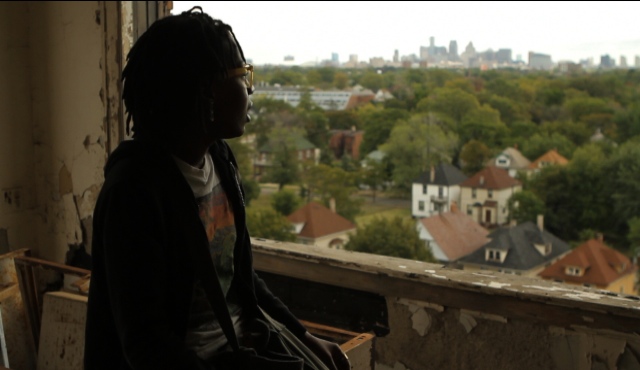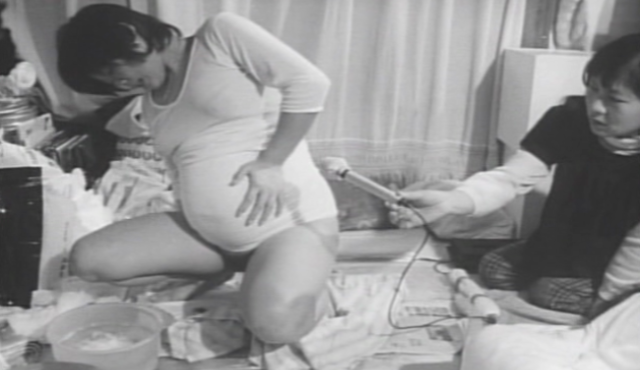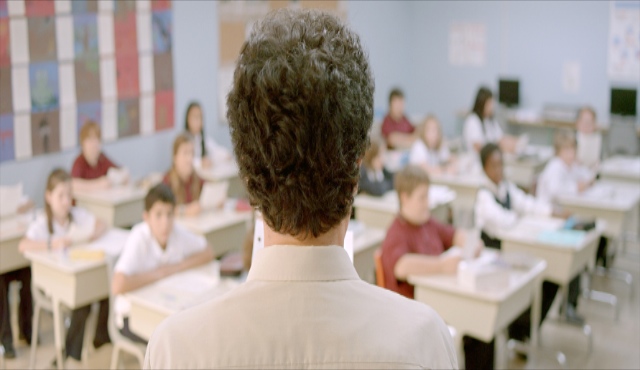
In Sidney J. Furie’s The Entity (1982), Carla Moran (Barbara Hershey) is violently attacked by a presence with no physicality. Intended as a supernatural suspense thriller rather than a horror film, The Entity received middling reviews on release, and seemed destined to be nothing more than another 1980s genre film. However, Austrian avant-gardist Peter Tscherkassky saw something else. In the early 2000s, he bought a 35mm print of The Entity for fifty dollars. The low price point was a major motivating factor behind his purchase, but the acquisition also fit with his next project: working with the materiality of film by experimenting with the role of the tangible celluloid print. From Furie’s feature film, Tscherkassky created two short works of film-art: Outer Space (2000) and Dream Work (2002). Transforming the materiality of the footage—the film stock itself—into a character, his films move beyond The Entity‘s generic categories of horror/thriller and enter an abstracted realm of the sublime. By using film stock as object, Tscherkassky ruptures the narrative world and creates two works wherein the character Carla no longer exists; instead, the woman bearing the brunt of the film’s brutality is Hershey herself. The shorts are not exercises in sadism, but rather critiques of mainstream cinema and its ideological abuse of female protagonists.
In The Entity, Carla is oppressed by an invisibile force, leading her sanity to be called into question. While we as viewers bear witness to the supernatural events as they occur, each of the men in the film doubt Carla’s claims—including her son (David Labiosa) and her lover (Alex Rocco). Carla’s fight against the abuse of the patriarchy must then begin by proving the existence of the menacing entity. The harder she fights, however, the more she is disbelieved, ignored, or (as is so often the case when it comes to men questioning female subjectivity) written off as crazy. Maintaining a clear-headed determination, she continues to fight against the entity and patriarchal oppression. But her tenacity seems to further incite or enrage the being, her resilience clearly representing a threat to its power.
Working with this story and using celluloid as his foundation, Tscherkassky builds upon The Entity‘s themes, but creates a much darker, more terrifying vision in his shorts. In painstakingly selecting and re-copying small details from the original film frames, he foregrounds the materiality of film, thus obliterating any sense of narrative or diegetic film world. As the marginal plot blends with the materiality of the film, the celluloid ceases to be the canvas and suddenly—violently—assumes responsibility for that which happens to the woman trapped inside the film frame. After selecting and “cutting out” these images, Tscherkassky then compiles up to seven layers of film. It is through this process of annihilating Furie’s narrative world, and in using the film itself to create the shorts, that Tscherkassky transfers the psychosis presented in The Entity from its female protagonist to the form of film itself.
Outer Space becomes the entity that haunts Barbara Hershey. The black screen is first allowed brief intervals of light and sound, illuminating the house from Furie’s film in which the entity (character) and The Entity (film as character) reside. The combination of light and sound create an intrusional blitz, much like a mosquito being caught in a bug zapper. The parallel is terrifying, evoking the realisation that Barbara Hershey is the mosquito, and her entry to the house is a type of death. As an extension of the original film, The Entity, it is the death of her sanity. Moreover, for Tscherkassky’s material permeation of the plot, it is the death of narrative, convention, linearity, and the parameters of the cinematic screen. Through separations and superimpositions, multiple Barbara Hersheys appear. As the laser pointer circles her eyes, two then three faces can be seen. The multiplicity of Barbara Hersheys represents women both in their plurality and as a uniform group. Trying to speak out against the attack, she is silenced. What is heard instead is a recording of optical sound, created through the practise of over-printing an image. In this way, the visual bleeds into the soundtrack, creating an aural experience of the optical. Having now confirmed that the film is a character—and the dominant one at that—Tscherkassky pits him/it squarely against Hershey, and all that she represents.
Representing a multiplicity of women as the preceding images suggest, Hershey is afraid of the film in which she is ingrained. She cannot escape it. Her only hope is to stay onscreen and continue her struggle in front of an audience; her presence acts as a weapon, but a weak one. There is a moment when the material film completely takes over the screen and becomes space itself; formless and limitless, it is the entity. This happens directly following an encounter between Hershey’s character and the celluloid sprockets; twisting and turning, moving in and out of the frame, they battle the space. In allowing the celluloid to dominate the screen, Tscherkassky illustrates the way film, particularly narrative cinema, is a powerful representational force. Like the entity, it is to be feared.
Dream Work delves further into the psyche of The Entity by exploding notions of time and space. This second short begins with the image of an open window, its curtain blowing in the wind to the rhythmic audio of a ticking clock. The window acts as a portal between the conscious and unconscious worlds of the diegesis and the narrative of the film itself. It is a physical representation of a “between space” that could open up pleasurable or terrifying experiences. The sound of the clock ticking establishes a temporal rhythm. As Hershey’s character lays down to sleep, this sound fades in and out, stops, doubles, quickens, slows, and continually returns to its established pace in a disorienting cycle. The disruption of temporal logic dissolves cinematic time. Tscherkassky further ruptures the cinematic space by layering multiple images on the screen. Without the structures of time and space within which to operate, all narrative code goes out the proverbial (or onscreen) window.
In stripping away these basic cinematic foundations, specificity is undone and Hershey becomes “woman”; a signifier for female characters in generic, narrative cinema (albeit still a white one). Constructed as such, Tscherkassky then purposefully abuses this fetishistic image. Midway through Dream Work, an indistinguishable man enters one side of the frame as a headless Barbara Hershey undresses on the other. As Hershey removes her bra to reveal her breasts—in tandem with the sound of her moaning in pleasure—a white, ghostly hand appears. The movement of the hand suggests masturbation, and is synced to Hershey’s movements as she writhes around on the bed. Distorted voices and a ringing alarm create a din as the footage of Hershey revealing her breasts is showed over and over again. The association becomes abject, occupying a strange liminal space between the sound of distorted pleasure and the visual fetishization of the female body. In the next image, Hershey is on a sofa being raped by the invisible entity. Those same ghostly hands are superimposed over layers of murky film stock, trying to fondle her already violated body. Leading to the film’s crescendo, the frame appears to be spinning, absolutely out of control. Whiteness and an eerie silence stop the spinning. The filmmaker—the author, the God, the ultimate symbol of the patriarch—appears in negative exposure, cutting and working on the film.
In reference to, and appreciation of, the surrealist photography of American modernist artist Man Ray—particularly his work with the rayograph—Tscherkassky places objects onto raw film stock and exposes the shadows they cast. He uses needles, tacks and coarse salt to achieve (in part) what Man Ray achieved: a camera-less film. Seeing the shadow of Tscherkassky’s hands literally cutting film reveals the artifice and creative processes involved in the work of film-art. Exposing technique in replacement of plot suspends any concept of a preconceived “film world.” When anything close to the narrative world does reappear, objects from the outer world linger. These haunt the woman/Carla/Hershey and act as a constant reminder that images are constructed and that the woman/Carla/Hershey is at the mercy of the filmmaker. The scissors almost dance in the corner of the screen, right next to her face, constantly suggesting a violent threat.
Absolutely in the hands of the creator, the woman onscreen becomes like a carnival sideshow—a mere attraction. Sandwiched against herself within the many layers of Tscherkassky’s work, she is trapped by the violent world of narrative cinema. Her suffering is symbolic. In one especially terrifying scene in Outer Space, we see Hershey smashing her mirrored reflection. In The Entity, this act is a side-effect of deep-rooted guilt, something she experiences after deriving unwanted pleasure from a sexual assault. In Outer Space, it is presented through a creation of obsessive framing. Drawing attention to the artifice of his own work, Tscherkassky shows Hershey repeatedly fighting back and smashing the image of the woman who took pleasure in her assault. Far from victim shaming, Tscherkassky’s vision of Hershey is one of a woman trying to break the taboo by smashing the image created by the dominant narrative—in this case the narrative in The Entity. Attacking the ideology instead of the woman, Tscherkassky’s abstractions reveal what’s really behind cinema’s smoke and mirrors. And it’s far more frightening than a ghost.





